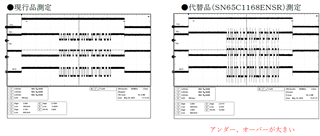Other Parts Discussed in Thread: SN65C1168, SN751178, THVD1500
Tool/software:
Hi all,
To replace the HD29051FP used as the RS-422 driver/receiver
We are considering using the SN65C1168E.
We replaced the SN65C1168E in the same environment as the HD29051FP and measured the waveform, and found the following difference.

We also checked the output waveform with the simulation tool. We confirmed similar overshoot and undershoot when a capacitive load was connected. We did.

1) Is the overshoot and undershoot caused by the capacitive load?
Is it possible that the same occurs with the SN751178NSR instead of the SN65C1168 E?
2) Is the overshoot and undershoot caused by the output current?
The output current of the SN65C1168E is ±20 mA, and the output of the HD29051FP is ±40 mA.
I think the output current of the SN751178NSR is ±60 mA. Does it not occur with the SN751178 NSR?
I would appreciate any comments.
Best Regards,
Ryusuke

